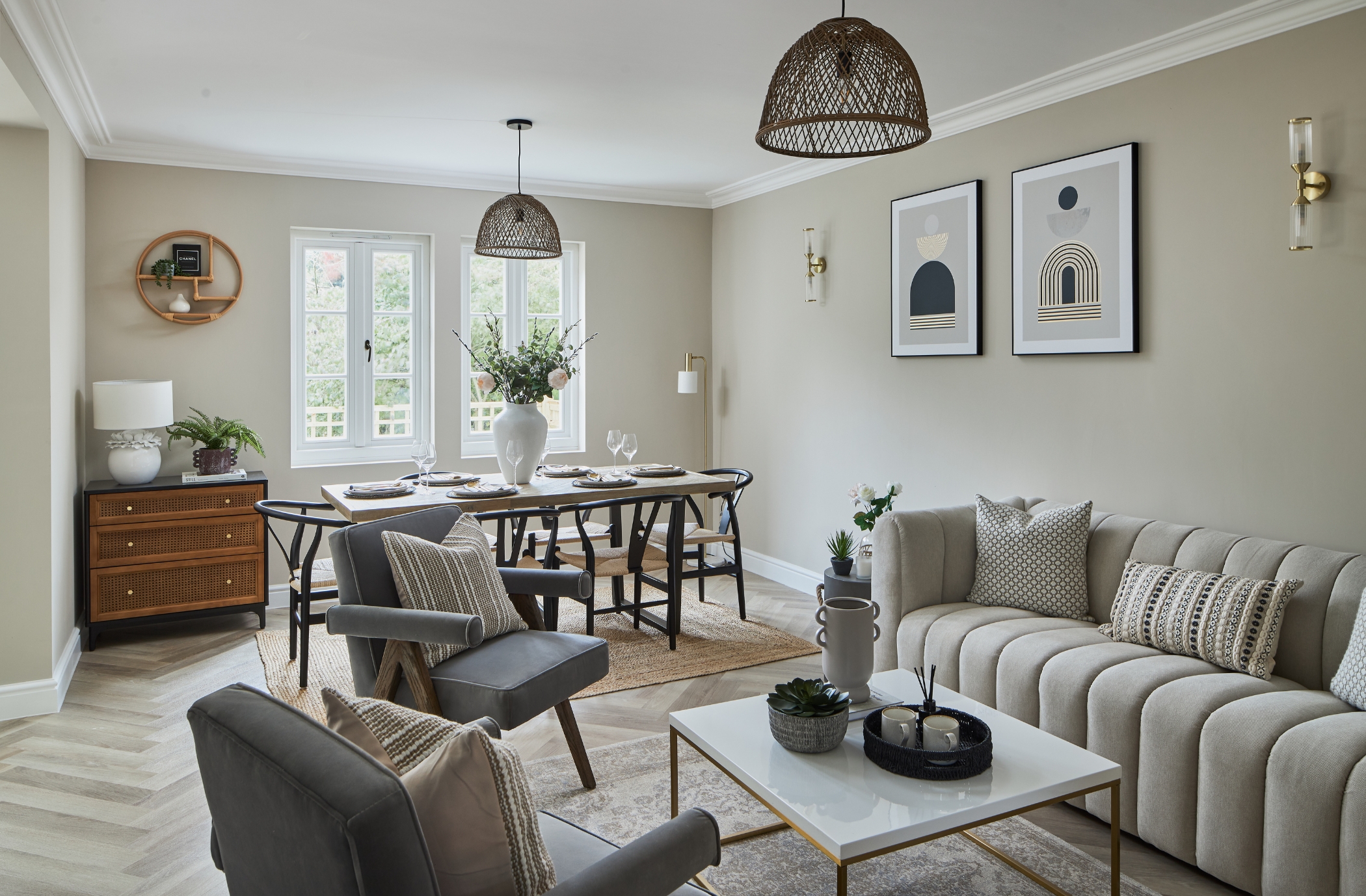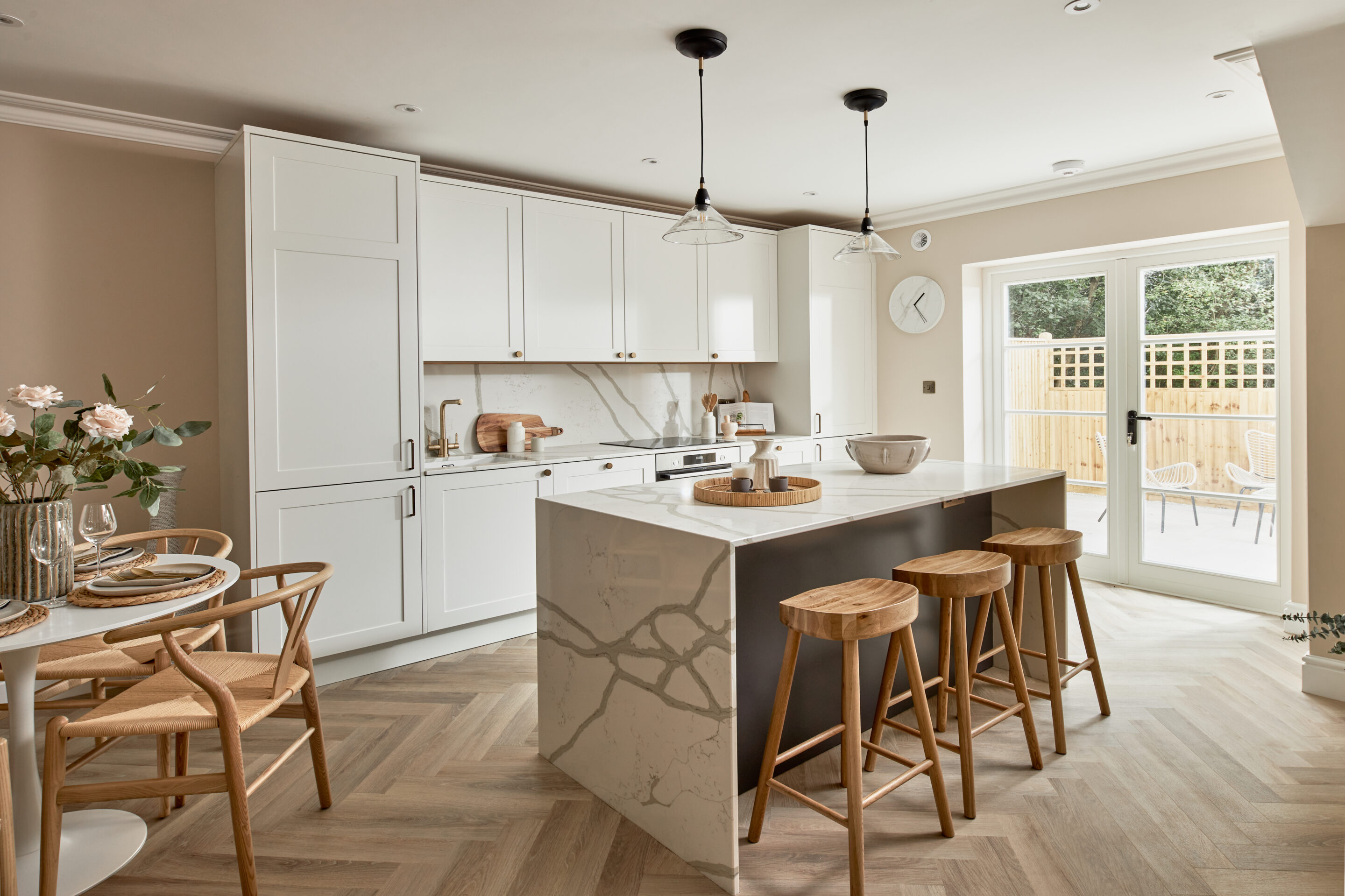Understanding the Target Market
Identifying the target market is crucial for effective real estate staging. Real estate professionals should conduct thorough research to understand the demographics, psychographics, and pain points of potential buyers in the local area. This allows staging strategies to be tailored to specific buyer personas such as young professionals, families, or empty nesters.
Buyer Personas
When staging a properties, it’s important to have a specific buyer persona in mind rather than trying to appeal to everyone. For example, staging for young professionals would focus on showcasing modern designs, technology integrations, and low-maintenance living. Staging for families may emphasise space for children, back garden features, and proximity to schools. Empty nester staging would highlight low-maintenance living, accessibility features, and proximity to amenities.
Market Research
Real estate professionals should analyse market reports, conduct area tours, review listing comments, and consult with agents familiar with the neighbourhood. This provides insights into buyer preferences and demographics such as average age, household income, lifestyle patterns etc. Staging can then align with local trends – for example, modern vs traditional designs. Keeping on top of new developments and neighbourhood changes also allows staging to meet evolving preferences.
In summary, the target audience directly impacts staging strategy. Customising staging based on market research and specific buyer personas makes a property more enticing and memorable for prospective buyers. This increases perceived value, shortens time on market, and supports optimal pricing.
Advanced Staging Techniques
Virtual staging has emerged as a powerful tool for real estate professionals to showcase a property’s potential, especially for vacant homes or new developments. By digitally furnishing empty spaces, agents can present a realistic vision of how the home could look when staged and decorated. This allows buyers to better visualise themselves living in the property.
Utilising Virtual Staging
The key benefits of virtual staging include:
- Cost-effective – Much more affordable than physical staging with real furniture and decor
- Versatile – Easily change styles, layouts, furnishings to match buyer preferences
- Accessible – Allow buyers from anywhere to view staged spaces through 3D tours and videos
- Eco-friendly – Eliminate waste from trucking in physical furnishings and decor
With the right software and an experienced virtual stager, vacant spaces can be transformed into warm, inviting home environments that entice buyers.
Implementing Luxury Staging
Luxury staging creates a sense of sophistication and grandeur suited to high-end properties. Techniques include:
- Showcasing architectural details – Moldings, high ceilings, hardwood floors
- Using high-end furnishings – Leather couches, ornate lamps, elegant dining sets
- Incorporating luxury accents – Crystal chandeliers, artwork, floral arrangements
- Staging outdoor spaces – Patios, pools, gardens, fountains
- Conveying exclusivity with accessories – Monogrammed linens, decanters, caviar service
Virtual staging allows agents to style spaces with expensive, aspirational furnishings that capture the imagination of affluent buyers.
Incorporating Lifestyle Staging
Lifestyle staging creates an emotional connection by showcasing a property’s potential to facilitate buyers’ aspirations and interests through design elements like:
- Yoga/Meditation Room – Serene decor, Buddha accents, greenery
- Home Theater – Leather seats, movie posters, popcorn cart
- Game Room – Pool table, dart board, card table, sports memorabilia
- Home Office – Desk, bookshelves, reading nook, productivity vision boards
Virtual staging can bring these personalised spaces to life to get buyers excited about the property accommodating their hobbies and passions.
Using Seasonal Staging
Seasonal virtual staging involves adapting the style and decor to reflect the feeling of the season, for example:
- Spring – Fresh flowers, light colours, open windows
- Summer – Patriotic accents, porch furniture, lemonade stand
- Fall – Warm tones, plaid blankets, pumpkin decor
- Winter – Evergreen garlands, red accents, lit fireplace
Conveying seasonal warmth encourages buyers to picture themselves enjoying the home year-round.
Maximising Property Features
When staging a property for sale, emphasising unique architectural details can create an immediate visual impact. Strategically highlight built-in bookshelves, crown moulding, arched doorways or specialty tilework. Clean, touch up or illuminate these special features to make them stand out. This draws buyers’ eyes to the craftsmanship and charm of the home.
Focal Points
Creating defined focal points also helps potential buyers remember the property. Carefully style vignettes around fireplaces or bay windows to create an alluring showcase. Use lighting, artwork or decorative items to accent these areas. Focal points display the functionality of spaces while helping memories stick in buyers’ minds.
Outdoor Staging
Curb appeal matters, so optimise outdoor areas too. Style patio furniture into cosy seating areas or set a table for alfresco dining. Incorporate pots, plants and lanterns to inject colour and ambiance. For green spaces, define play areas, reading nooks or an entertainment zone. Extending living areas outside promotes livability and homey vibes.
Advanced Tips for Different Property Types
When staging flats and apartments, it’s important to make the most of the available space. Clever storage solutions like built-in shelving, sliding doors, and furniture with hidden compartments can help maximise functionality. Bold accent walls, modern light fixtures, and sleek, minimalist décor create a contemporary vibe. Space-saving furniture such as nesting tables, and convertible pieces allow buyers to envision the versatility of the property.
Luxury Estates
Luxury estates demand staging that conveys affluence and sophistication. Chandeliers, crown moulding, hardwood floors, and ornate rugs establish grandeur. Artwork, sculptures, and decorative pieces should reflect worldly tastes. Spaces like home theatres, wine cellars, and sitting rooms cater to lavish lifestyles. Outdoor areas can highlight resort-style amenities like infinity pools, outdoor kitchens, and fire pits. The goal is to captivate high-end buyers with a glimpse into the world of luxury they can own.
Historical Properties
Staging historic properties requires balancing modern updates with preserving original architectural details. Keep changes reversible and consistent with the property’s period. Spotlight character features like clawfoot tubs, mosaic tile, wood burning fireplaces, crown moulding and hardwood floors. Incorporate antique furnishings and vintage-inspired accents for homage to the past. The focus should be on showcasing the property’s unique heritage.
Leveraging Technology
Technology is rapidly transforming the real estate industry, providing exciting new tools and capabilities to showcase properties in innovative ways. By leveraging the latest technology, real estate professionals can create more immersive and interactive experiences to attract prospective buyers.
Utilising 3D Tours and Virtual Reality
One of the most cutting-edge technologies being utilised is 3D tours and virtual reality. These technologies allow potential buyers to digitally walk through a property and visualise themselves living in the space. Virtual reality takes the experience even further by allowing buyers to immerse themselves in the property using VR headsets. This creates an emotional connection and sense of presence that 2D photos and videos simply cannot match.
Integrating Smart Home Technology
Smart home technology is exploding in popularity, especially with younger, tech-savvy homebuyers. Integrating features like smart thermostats, automated lighting, and voice assistants can give a property a high-tech, cutting edge feel. When staging a smart home, real estate agents should highlight the convenience and lifestyle benefits these features provide.
Incorporating Aerial Photography and Video
Drones and aerial photography allow real estate professionals to showcase properties and surrounding areas in an exciting new way. Capturing stunning bird’s-eye views of the home, neighbourhood, and natural landscapes can highlight desirable features that might otherwise go unnoticed. This technology leaves a memorable impression and differentiates listings.
By embracing cutting-edge real estate technology, agents can create more immersive digital experiences, reach tech-savvy buyers, and give their listings the competitive edge needed to stand out in today’s market.
Working with Staging Professionals
Collaborating with experienced staging experts can provide invaluable benefits for real estate professionals looking to elevate their property presentations. These specialists have extensive expertise in interior design, decorating trends, and showcasing homes in the best possible light. By tapping into their skills, insights and access to quality furnishings, realtors can create memorable impressions for potential buyers.
When selecting staging partners, it helps to research their background and portfolio. Look for stagers with a proven track record in your local market. They will understand the latest trends and styles that appeal to buyers in your area. Also ensure they have experience staging similar property types to yours. This niche expertise can maximise the impact of their design choices.
While professional staging does require an upfront investment, it’s important to view it as a worthwhile expense that can boost your sales price and shorten time on market. Attractive staging helps buyers visualise themselves living in the home. This emotional connection prompts more showings and offers.
Analyse comparable sold homes to estimate the potential pricing lift from staging upgrades. Track your staging expenses and sale price as market data to quantify the return on investment. Use these metrics to determine an optimal staging budget that makes financial sense for each listing.
By taking an analytical approach, real estate agents can demonstrate the lucrative payoff of staging expenses for sellers. This helps secure buy-in for allocating more funds towards furnishings, accessories and upgrade materials. Stage enough to make a noticeable difference, while avoiding over-improvements that exceed the neighbourhood’s value range.
Key Takeaways
- Partner with experienced staging experts to access specialised skills and quality furnishings
- View staging as an investment that boosts sales price and shortens time on market
- Analyse comparable sales and track metrics to optimise staging budget
Conclusion
As we have seen throughout this blog post, advanced staging techniques can have a tremendous impact on enhancing a property’s appeal and attractiveness to potential buyers. By taking the time to understand the target demographic and tailoring the staging strategy accordingly, real estate professionals can create an emotional connection and convey the lifestyle possibilities a home offers.
Implementing creative staging approaches like virtual staging, luxury staging, lifestyle staging, and seasonal décor can showcase a home’s full potential. Drawing attention to architectural details, creating focal points, and optimising outdoor spaces also help make great first impressions on buyers.
Additionally, leveraging technology through 3D tours, drones, and smart home tech allows buyers to fully visualise themselves living in the space. And collaborating with seasoned staging experts leverages their wealth of expertise in furnishings, layouts, and the latest trends.
The key is to align the staging techniques with the unique property type, whether a historic home, downtown condo, or suburban estate. This level of personalization and strategic marketing is what converts showings into sales in today’s competitive market.
By implementing these advanced staging best practices, real estate agents can truly showcase what makes a house a home, resulting in more offers, shorter days on market, and higher sale prices for their clients.





